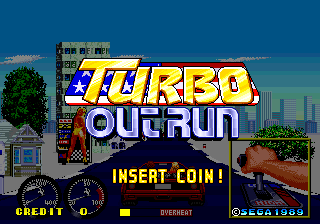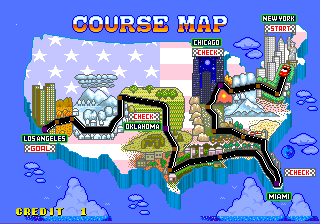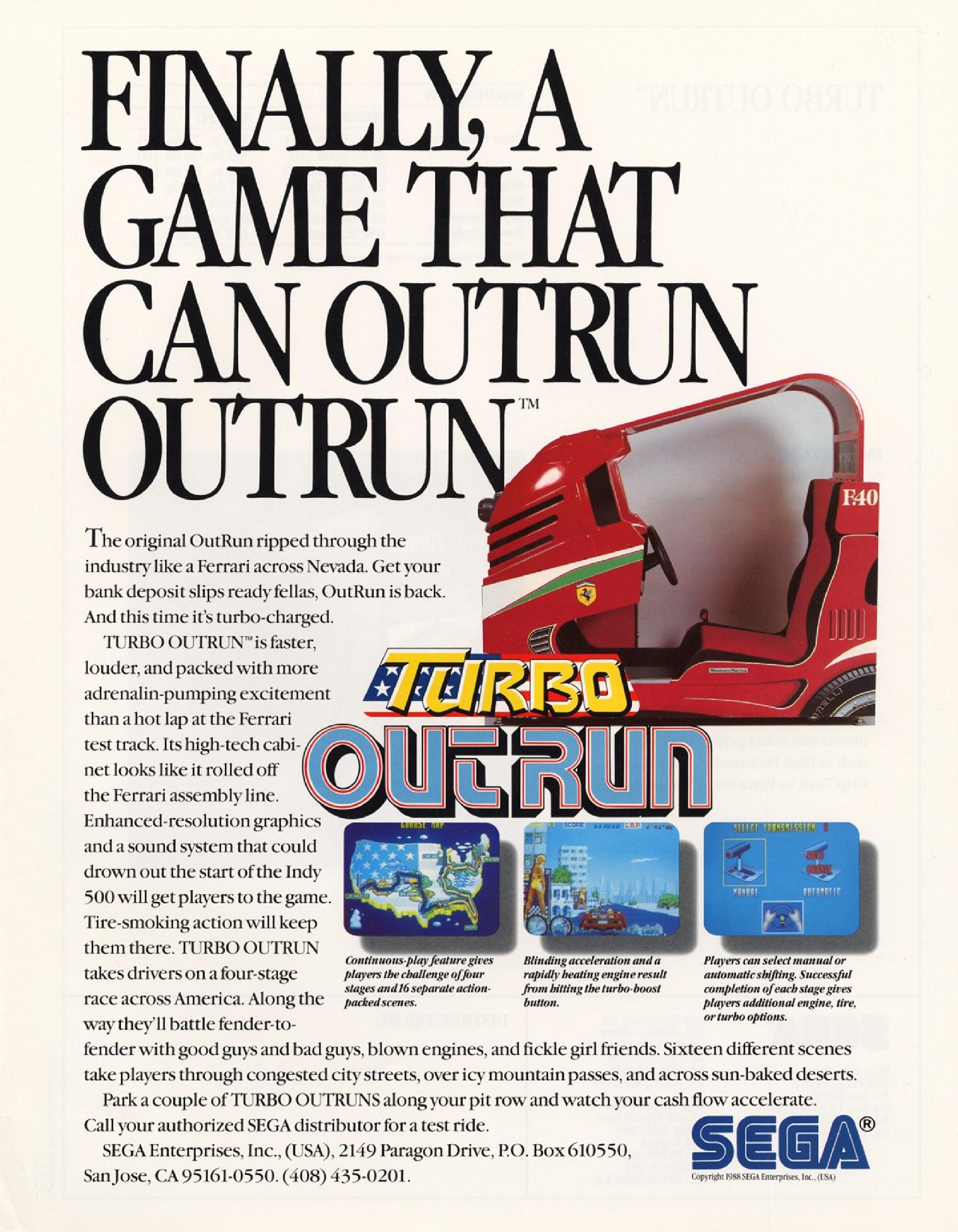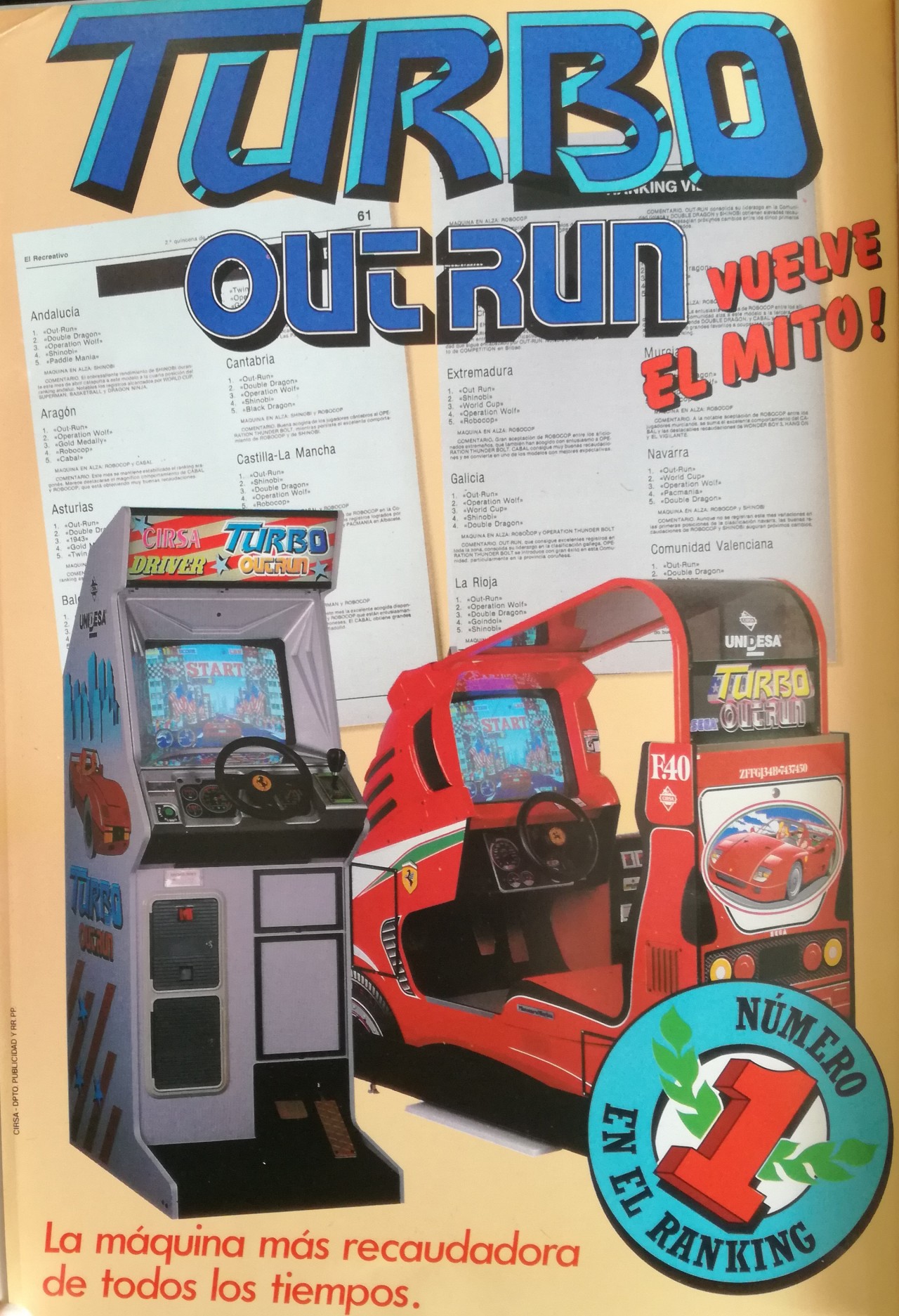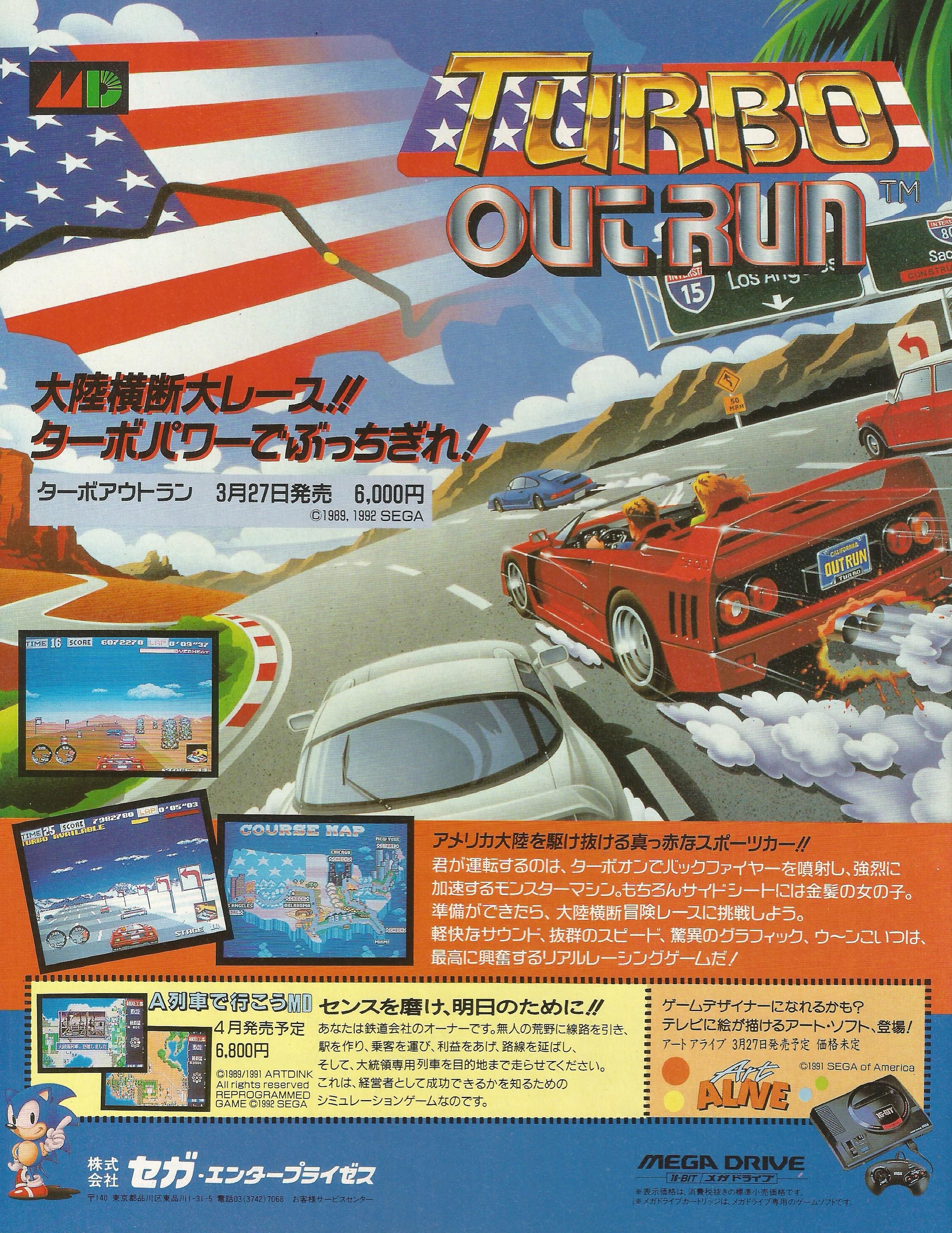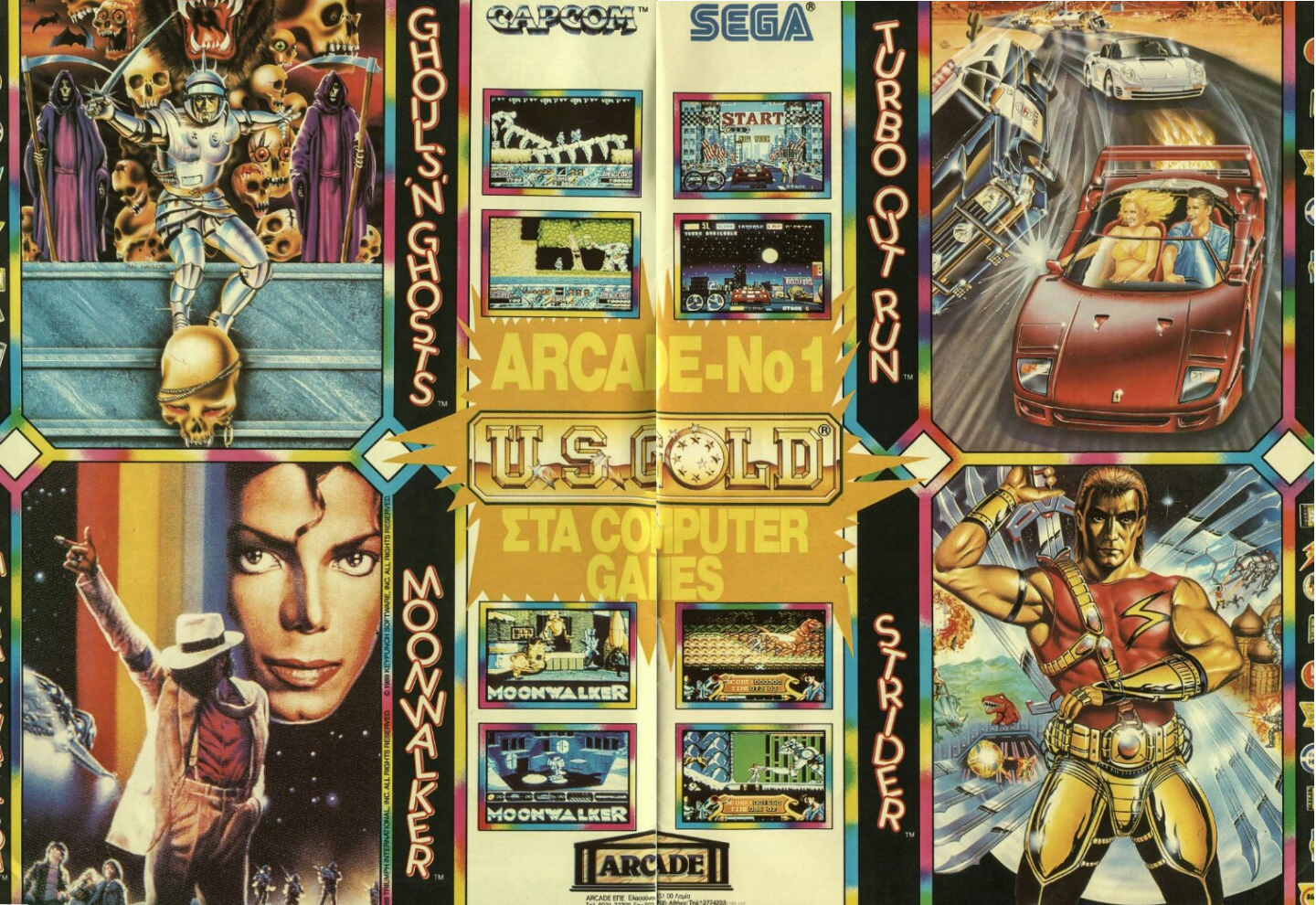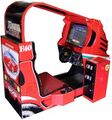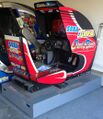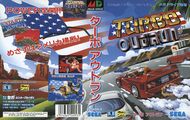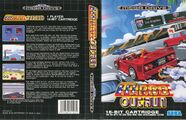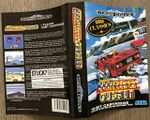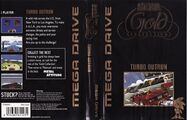Difference between revisions of "Turbo OutRun"
From Sega Retro
Hyperspeed34 (talk | contribs) |
|||
| (152 intermediate revisions by 17 users not shown) | |||
| Line 1: | Line 1: | ||
| + | {{OtherPage|desc=non-FM Towns home computer versions|page=Turbo OutRun (home computers)}} | ||
{{Bob | {{Bob | ||
| bobscreen=Turbo OutRun Title.png | | bobscreen=Turbo OutRun Title.png | ||
| − | | | + | | bobscreen2=TurboOutRun MD TitleScreen.png |
| − | | | + | | tab1=OutRun hardware |
| − | | publisher=[[Sega]] | + | | tab2=Mega Drive |
| − | | developer=[[Sega | + | | licensor={{company|[[Sega Enterprises, Ltd.]]|system=FMTowns}} |
| − | | system=[[Sega OutRun | + | | publisher={{company|[[Sega Enterprises, Ltd.]]|system=OUTRUN,MD}} |
| − | | romsize={{ | + | {{company|[[CRI]]|system=FMTowns}} |
| + | | developer={{company|[[Sega R&D 8]]{{magref|segamagjp|4|24}}|system=OUTRUN}} | ||
| + | {{company|[[Tiertex]]|system=MD}} | ||
| + | {{company|[[CRI]]|system=FMTowns}} | ||
| + | | distributor={{company|[[Unidesa]]|system=OUTRUN|region=ES}} | ||
| + | {{company|[[Ecofilmes]]|region=PT|system=MD}} | ||
| + | | system=[[Sega OutRun hardware]], [[Sega Mega Drive]], [[FM Towns]] | ||
| + | | romsize={{Arcade}} 2376kB | ||
| sounddriver= | | sounddriver= | ||
| peripherals= | | peripherals= | ||
| − | | genre=Racing | + | | players=1 |
| − | | releases={{ | + | | genre=Racing{{fileref|TurboOutRun MD JP Box.jpg}}{{ref|https://web.archive.org/web/20200720095133/https://sega.jp/history/hard/megadrive/software.html}} |
| − | | | + | | releases={{releasesArcade |
| − | | | + | | outrun_date_jp=1989-02-11 |
| − | | md_date_jp=1992-03-27 | + | | outrun_date_us=1989 |
| + | | megatech_date_uk=199x | ||
| + | }} | ||
| + | {{releasesMD | ||
| + | | md_date_jp=1992-03-27{{ref|https://web.archive.org/web/20200720095133/https://sega.jp/history/hard/megadrive/software.html}} | ||
| md_code_jp=G-4053 | | md_code_jp=G-4053 | ||
| md_rrp_jp=6,000 | | md_rrp_jp=6,000 | ||
| + | | md_date_eu=1992-06 | ||
| + | | md_code_eu=1123 | ||
| + | | md_date_uk=1992-05{{magref|ctw|389|19}} | ||
| + | | md_code_uk=1123 | ||
| + | | md_rrp_uk=34.99{{magref|segapower|30|39}} | ||
| + | | md_date_au=199x | ||
| md_date_au_sgc=199x | | md_date_au_sgc=199x | ||
| − | | | + | | md_code_au_sgc=FTUR06SMC |
| − | | | + | | md_date_pt=199x |
| − | |||
| − | |||
| − | |||
| − | |||
| − | |||
| − | |||
| − | |||
| − | |||
| − | |||
| − | |||
| − | |||
| − | |||
| − | |||
| − | |||
| − | |||
| − | |||
| − | |||
}} | }} | ||
| + | {{releasesHCJP | ||
| + | | fmtowns_date_jp=1989-11-15{{ref|https://web.archive.org/web/20230814210957/https://media.vgm.io/albums/47/5474/5474-1503477708.jpg}} | ||
}} | }} | ||
| − | ''''' | + | }} |
| + | {{stub}}'''''{{PAGENAME}}''''' (ターボアウトラン) is an arcade sequel to ''[[OutRun]]'' released in 1989. Though not the first sequel to ''OutRun'', ''Turbo OutRun'' is considered to be the first "true" sequel, having been built by a similar team at [[Sega AM2]] with the arcades in mind. | ||
| + | |||
| + | ==Gameplay== | ||
| + | [[File:TurboOutRun Course.png|left]]''Turbo OutRun'' has the player make a journey across the United States of America, from New York to Los Angeles. It is a more linear game than its predecessor, offering no forks in the road and therefore less of an incentive to play the game again after completion. | ||
| − | + | For the most part, the game is very similar to its predecessor, save for new graphics and music. ''Turbo OutRun'' offers several new features however, such as weather effects and obstacles which can slow your journey down. Like its predecessor, the player drives a car which looks suspiciously like Ferrari, however rather than being based on a [[wikipedia:Ferrari Testarossa|Ferrari Testarossa]], it is a [[wikipedia:Ferrari F40|Ferrari F40]] (although like its predecessor, ''Turbo OutRun'''s car is fictional convertible version of the car, which Ferrari did not manufacture). You are also set against a rival opponent, driving what appears to be a white [[wikipedia:Porsche 959|Porsche 959]] (a nod towards the rivalry between Ferrari and Porsche at that time). | |
| − | |||
| − | + | The game is divided into four "sub-goals". Upon reaching a goal, the player is able to upgrade their car. If the opponent gets to the goal first, the player's girlfriend will sit in the opponent car in the next race, however if the player gets there first, a 1,000,000 point bonus is given. | |
| − | + | The other major addition to ''Turbo OutRun'' is the inclusion of a "Turbo" feature: the back of the car has a rocket-type exhaust on the back and the player is given a "boost" button, which allows the car to travel faster. If the boost is left on for too long however, the car will overheat, and will be punished with slowdown. It is also the first ''OutRun'' game to offer an automatic transmission option. | |
| − | + | ||
| + | After each goal, the player is taken to a shop where they can apply one of three upgrades to their car: a better engine, high-grip tires, or a better turbo. Each upgrade may be applied only once, and since there are four sections, the player will eventually have a maxed-out car. | ||
| + | |||
| + | The arcade version also allows you to continue from the beginning of the stage if you lose, a feature that did not survive into later ''OutRun'' games. | ||
| + | |||
| + | There are four stage songs: "Rush a Difficulty", "Keep Your Heart", "Shake the Street", and "Who Are You". Unlike in other ''OutRun'' games, the player cannot choose the song currently playing — they are tied to each section. Additionally, every version of the game appears to use a different song order, and the [[Sega Mega Drive]] port changes the song titles ("Insanity", "Highway", "Main Theme", and "Funky run", respectively, in addition to having its own songs). | ||
| + | |||
| + | ===Stages=== | ||
| + | {{InfoTable|imagewidths=200| | ||
| + | {{InfoRow | ||
| + | | title=New York | ||
| + | | image=Notavailable.svg | ||
| + | | desc= | ||
| + | }} | ||
| + | {{InfoRow | ||
| + | | title=Washington D.C | ||
| + | | image=Notavailable.svg | ||
| + | | desc= | ||
| + | }} | ||
| + | {{InfoRow | ||
| + | | title=Pittsburgh | ||
| + | | image=Notavailable.svg | ||
| + | | desc= | ||
| + | }} | ||
| + | {{InfoRow | ||
| + | | title=Indianapolis | ||
| + | | image=Notavailable.svg | ||
| + | | desc= | ||
| + | }} | ||
| + | {{InfoRow | ||
| + | | title=Chicago | ||
| + | | image=Notavailable.svg | ||
| + | | desc= | ||
| + | }} | ||
| + | {{InfoRow | ||
| + | | title=St Louis | ||
| + | | image=Notavailable.svg | ||
| + | | desc= | ||
| + | }} | ||
| + | {{InfoRow | ||
| + | | title=Memphis | ||
| + | | image=Notavailable.svg | ||
| + | | desc= | ||
| + | }} | ||
| + | {{InfoRow | ||
| + | | title=Atlanta | ||
| + | | image=Notavailable.svg | ||
| + | | desc= | ||
| + | }} | ||
| + | {{InfoRow | ||
| + | | title=Miami | ||
| + | | image=Notavailable.svg | ||
| + | | desc= | ||
| + | }} | ||
| + | {{InfoRow | ||
| + | | title=New Orleans | ||
| + | | image=Notavailable.svg | ||
| + | | desc= | ||
| + | }} | ||
| + | {{InfoRow | ||
| + | | title=San Antonio | ||
| + | | image=Notavailable.svg | ||
| + | | desc= | ||
| + | }} | ||
| + | {{InfoRow | ||
| + | | title=Dallas | ||
| + | | image=Notavailable.svg | ||
| + | | desc= | ||
| + | }} | ||
| + | {{InfoRow | ||
| + | | title=Oklahoma City | ||
| + | | image=Notavailable.svg | ||
| + | | desc= | ||
| + | }} | ||
| + | {{InfoRow | ||
| + | | title=Denver | ||
| + | | image=Notavailable.svg | ||
| + | | desc= | ||
| + | }} | ||
| + | {{InfoRow | ||
| + | | title=Grand Canyon | ||
| + | | image=Notavailable.svg | ||
| + | | desc= | ||
| + | }} | ||
| + | {{InfoRow | ||
| + | | title=Los Angeles | ||
| + | | image=Notavailable.svg | ||
| + | | desc= | ||
| + | }} | ||
| + | }} | ||
| − | + | ==History== | |
| + | ===Development=== | ||
| + | Though very different to the rest of the series, ''Turbo OutRun'' is arguably closer to [[Yu Suzuki]]'s vision for the original ''OutRun'', being set in the United States of America and featuring various scrapped ideas such as a checkpoint system. | ||
| − | + | Like ''OutRun'' Ferrari were not consulted during the development of this game, although the Ferrari brand is used on ''Turbo OutRun'' arcade cabinets. | |
| − | + | ===Release=== | |
| + | ''Turbo OutRun'' was released as both a stand-alone arcade cabinet and as an upgrade kit to the original ''OutRun''. The upgrade kits offer very minor aesthetic changes - a different marquee and extra "Turbo" stickers. Some ''Turbo OutRun'' cabinets were converted back into regular ''OutRun'' machines as the prior game proved more popular - ''Turbo OutRun'' cabinets can be identified by the use of Ferrari branding. | ||
| − | == | + | ===Legacy=== |
The game was ported to the [[Sega Mega Drive]] in 1992 exclusively in Japan and Europe, and was brought to the Amiga, Amstrad CPC, Atari ST, Commodore 64, DOS computers and ZX Spectrum too. Each of these ports suffer from cutbacks as sprite scaling is not supported by these systems. | The game was ported to the [[Sega Mega Drive]] in 1992 exclusively in Japan and Europe, and was brought to the Amiga, Amstrad CPC, Atari ST, Commodore 64, DOS computers and ZX Spectrum too. Each of these ports suffer from cutbacks as sprite scaling is not supported by these systems. | ||
| − | ==Physical | + | ==Production credits== |
| − | ===Arcade | + | {{mainArticle|{{PAGENAME}}/Production credits}} |
| − | {{ | + | ===OutRun hardware version=== |
| + | {{creditstable| | ||
| + | *'''Game Design:''' [[Satoshi Mifune|Bin]] | ||
| + | *'''Program:''' [[Satoshi Mifune|Bin]], [[Coma]], [[Keiji Okayasu|Okape]]{{magref|segamagjp|4|24}} | ||
| + | *'''Design:''' [[Mr.Jee]], [[Papa]], [[Gudon]] | ||
| + | *'''Sound:''' [[Yasuhiro Takagi|Kerotan]], [[Hiroshi Kawaguchi|Hiro]] | ||
| + | *'''Sp. Thanks:''' [[Hiroshi Hamagaki|Sada]], [[Yu.]] | ||
| + | |||
| + | *'''Presented by:''' ©[[Sega]] | ||
| + | | console=OUTRUN | ||
| + | }} | ||
| + | {{hr}} | ||
| + | {{creditstable| | ||
| + | *'''Design:''' [[Akihito Hiroyoshi]]{{ref|https://web.archive.org/web/20201017011151/https://twitter.com/a_piroyoshi/status/1317271986830077952}}{{ref|https://web.archive.org/web/20220522103631/https://twitter.com/a_piroyoshi/status/1528323879499796480}} | ||
| + | | source=Developer mentions | ||
| + | | console=OUTRUN | ||
| + | }} | ||
| + | |||
| + | The game also contains high scores that reference the developers. | ||
| + | *[[Satoshi Mifune]] (BIN) | ||
| + | *KEN | ||
| + | *[[Keiji Okayasu]] (OKA) | ||
| + | *[[Yasuhiro Takagi]] (TKG) | ||
| + | *[[Hiroshi Miyauchi]] (HIR) | ||
| + | *TAM | ||
| + | *[[Coma]] (COM) | ||
| + | |||
| + | ===Mega Drive version=== | ||
| + | {{creditstable| | ||
| + | *'''Cover artist:''' [[Akira Watanabe]] | ||
| + | | console=MD | ||
| + | | source=[[Sega TV Game Genga Gallery]] | ||
| + | | pdf=Sega TV Game Genga Gallery.pdf | ||
| + | | pdfpage=124 | ||
| + | }} | ||
| + | |||
| + | ==Magazine articles== | ||
| + | {{mainArticle|{{PAGENAME}}/Magazine articles}} | ||
| + | |||
| + | ==Promotional material== | ||
| + | {{gallery | ||
| + | |{{gitem|TurboOutRun Arcade US Flyer.pdf|page=1|Arcade US flyer}} | ||
| + | |{{gitem|Turbo OutRun Arcade US Flyer Alt.jpg|Arcade US flyer (conversion kit)}} | ||
| + | |{{gitem|TurboOutRun Arcade JP Flyer.pdf|page=1|Arcade JP flyer}} | ||
| + | |{{gitem|TurboOutRun Arcade ES Flyer.jpg|Arcade ES flyer}} | ||
| + | |{{gitem|TurboOutRun MD JP PrintAdvert.jpg|Mega Drive JP print advert}} | ||
| + | |{{galleryPrintAd|CG GR 2 US Gold advert.png|cggr|2|}} | ||
| + | |{{galleryPrintAd|bemega|1992-04|4}} | ||
| + | }} | ||
| + | |||
| + | ===Merchandise=== | ||
| + | <gallery> | ||
| + | TurboOutRun PhoneCard JP Front.jpg|[[Sega Game Card]] | ||
| + | </gallery> | ||
| + | |||
| + | ==Photo gallery== | ||
| + | <gallery> | ||
| + | TurboOutRun Arcade US Cabinet Upright.jpg|Upright cabinet | ||
| + | TurboOutRun Arcade US Cabinet Sitdown.jpg|Sit-down cabinet | ||
| + | TurboOutRun Arcade US Cabinet Upright OutRunConversion.jpg|Upright cabinet (converted from ''[[OutRun]]'') | ||
| + | TurboOutRun Arcade US Cabinet Standard OutRunConversion.jpg|Standard cabinet (converted from ''[[OutRun]]'') | ||
| + | </gallery> | ||
| + | |||
| + | ==Physical scans== | ||
| + | ===Arcade version=== | ||
| + | {{ratings|OUTRUN}} | ||
| + | {{ScanArcade | ||
| + | | type=upright | ||
| console=Arcade | | console=Arcade | ||
| region=US | | region=US | ||
| − | + | }}{{ScanArcade | |
| − | + | | type=upright | |
| − | }}{{ | ||
| − | |||
| − | | | ||
| − | |||
| − | |||
| console=Arcade | | console=Arcade | ||
| region=JP | | region=JP | ||
| − | |||
| − | |||
}} | }} | ||
| − | ===Mega Drive | + | ===Mega Drive version=== |
| + | {{ratings|MD}} | ||
{{Scanbox | {{Scanbox | ||
| + | | console=Mega Drive | ||
| + | | region=JP | ||
| + | | cover=TurboOutRun MD JP Box.jpg | ||
| + | | cart=TurboOutRun MD JP Cart.jpg | ||
| + | | carttop=TurboOutRun MD JP CartTop.jpg | ||
| + | | manual=TurboOutRun MD jp manual.pdf | ||
| + | }}{{Scanbox | ||
| console=Mega Drive | | console=Mega Drive | ||
| region=EU | | region=EU | ||
| − | | | + | | cover=Turbo OutRun MD EU Box.jpg |
| − | | cart= | + | | cart=TurboOutRun MD EU Cart.jpg |
| + | | manual=Turbo Outrun MD EU Manual.jpg | ||
| + | | item1=TurboOutRun MD EU pcb.jpg | ||
| + | | item1name=PCB | ||
| + | }}{{Scanbox | ||
| + | | console=Mega Drive | ||
| + | | region=PT | ||
| + | | cover=TurboOutRun MD PT cover.jpg | ||
| + | | cart=TurboOutRun MD EU Cart.jpg | ||
| + | | manual=TurboOutRun MD PT manual.jpg | ||
| + | | item1=Turbo Outrun MD EU Manual.jpg | ||
| + | | item1name=EU Manual | ||
}}{{Scanbox | }}{{Scanbox | ||
| console=Mega Drive | | console=Mega Drive | ||
| − | | region= | + | | region=AU |
| − | | | + | | cover=TurboOutRun MD AU cover.jpg |
| − | | cart= | + | | cart=Turbo Outrun MD AU Cart.jpg |
| + | | manual=Turbo Outrun MD AU Manual.jpg | ||
}}{{Scanbox | }}{{Scanbox | ||
| console=Mega Drive | | console=Mega Drive | ||
| region=AU ([[Sega Gold Collection]]) | | region=AU ([[Sega Gold Collection]]) | ||
| − | | | + | | cover=TurboOutRun MD AU Box Gold.jpg |
| − | | cart= | + | | cart=Turbo Outrun MD AU Cart.jpg |
| + | | manual=Turbo Outrun MD AU Manual.jpg | ||
}} | }} | ||
| − | === | + | ===Mega-Tech version=== |
| − | |||
| − | |||
| − | |||
| − | |||
| − | |||
{{Scanbox | {{Scanbox | ||
| − | | console= | + | | console=Mega-Tech |
| − | | region= | + | | region= |
| − | | | + | | cover= |
| + | | cart= | ||
}} | }} | ||
| − | + | ===FM Towns version=== | |
| − | |||
| − | |||
| − | |||
| − | |||
| − | |||
| − | |||
| − | |||
| − | |||
| − | |||
| − | |||
| − | |||
| − | |||
| − | |||
| − | |||
| − | |||
| − | |||
| − | |||
| − | |||
| − | |||
| − | |||
| − | |||
| − | |||
| − | |||
| − | |||
| − | |||
| − | |||
| − | |||
| − | |||
| − | |||
| − | |||
| − | |||
| − | |||
| − | |||
| − | |||
| − | |||
| − | |||
| − | |||
| − | |||
| − | |||
| − | |||
| − | |||
| − | |||
| − | |||
| − | ===FM Towns | ||
{{Scanbox | {{Scanbox | ||
| console=FM Towns | | console=FM Towns | ||
| Line 156: | Line 287: | ||
}} | }} | ||
| − | == | + | ==Technical information== |
| − | {{ | + | {{mainArticle|{{PAGENAME}}/Technical information}} |
| − | + | ||
| − | + | ==References== | |
| − | | | + | <references/> |
| − | |||
| − | |||
| − | |||
| − | |||
| − | }} | ||
| − | |||
| − | |||
| − | |||
| − | }} | ||
| − | |||
| − | |||
| − | |||
| − | |||
| − | |||
| − | |||
| + | {{TurboOutRunOmni}} | ||
{{OutRun}} | {{OutRun}} | ||
| − | + | [[Category:Mega-Tech games]] | |
| − | |||
| − | |||
| − | |||
| − | |||
| − | |||
| − | |||
| − | |||
| − | |||
| − | |||
| − | |||
| − | [[Category:Mega-Tech | ||
Latest revision as of 02:31, 8 November 2024
- For non-FM Towns home computer versions, see Turbo OutRun (home computers).
| ||||||||||||||||||||||||||||||||||||||||||||||||||||
| Turbo OutRun | ||||||||||||||||||||||||||||||||||||||||||||||||||||
|---|---|---|---|---|---|---|---|---|---|---|---|---|---|---|---|---|---|---|---|---|---|---|---|---|---|---|---|---|---|---|---|---|---|---|---|---|---|---|---|---|---|---|---|---|---|---|---|---|---|---|---|---|
| System(s): Sega OutRun hardware, Sega Mega Drive, FM Towns | ||||||||||||||||||||||||||||||||||||||||||||||||||||
| Publisher: Sega Enterprises, Ltd. CRI | ||||||||||||||||||||||||||||||||||||||||||||||||||||
| Developer: Sega R&D 8[1] Tiertex CRI | ||||||||||||||||||||||||||||||||||||||||||||||||||||
| Distributor: Unidesa (ES) Ecofilmes (PT) | ||||||||||||||||||||||||||||||||||||||||||||||||||||
| Licensor: Sega Enterprises, Ltd. | ||||||||||||||||||||||||||||||||||||||||||||||||||||
| Genre: Racing[2][3] | ||||||||||||||||||||||||||||||||||||||||||||||||||||
| Number of players: 1 | ||||||||||||||||||||||||||||||||||||||||||||||||||||
|
This short article is in need of work. You can help Sega Retro by adding to it.
Turbo OutRun (ターボアウトラン) is an arcade sequel to OutRun released in 1989. Though not the first sequel to OutRun, Turbo OutRun is considered to be the first "true" sequel, having been built by a similar team at Sega AM2 with the arcades in mind.
Contents
Gameplay
Turbo OutRun has the player make a journey across the United States of America, from New York to Los Angeles. It is a more linear game than its predecessor, offering no forks in the road and therefore less of an incentive to play the game again after completion.
For the most part, the game is very similar to its predecessor, save for new graphics and music. Turbo OutRun offers several new features however, such as weather effects and obstacles which can slow your journey down. Like its predecessor, the player drives a car which looks suspiciously like Ferrari, however rather than being based on a Ferrari Testarossa, it is a Ferrari F40 (although like its predecessor, Turbo OutRun's car is fictional convertible version of the car, which Ferrari did not manufacture). You are also set against a rival opponent, driving what appears to be a white Porsche 959 (a nod towards the rivalry between Ferrari and Porsche at that time).
The game is divided into four "sub-goals". Upon reaching a goal, the player is able to upgrade their car. If the opponent gets to the goal first, the player's girlfriend will sit in the opponent car in the next race, however if the player gets there first, a 1,000,000 point bonus is given.
The other major addition to Turbo OutRun is the inclusion of a "Turbo" feature: the back of the car has a rocket-type exhaust on the back and the player is given a "boost" button, which allows the car to travel faster. If the boost is left on for too long however, the car will overheat, and will be punished with slowdown. It is also the first OutRun game to offer an automatic transmission option.
After each goal, the player is taken to a shop where they can apply one of three upgrades to their car: a better engine, high-grip tires, or a better turbo. Each upgrade may be applied only once, and since there are four sections, the player will eventually have a maxed-out car.
The arcade version also allows you to continue from the beginning of the stage if you lose, a feature that did not survive into later OutRun games.
There are four stage songs: "Rush a Difficulty", "Keep Your Heart", "Shake the Street", and "Who Are You". Unlike in other OutRun games, the player cannot choose the song currently playing — they are tied to each section. Additionally, every version of the game appears to use a different song order, and the Sega Mega Drive port changes the song titles ("Insanity", "Highway", "Main Theme", and "Funky run", respectively, in addition to having its own songs).
Stages
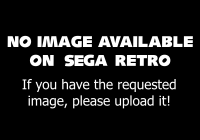
|
New York |
|---|---|

|
Washington D.C |

|
Pittsburgh |

|
Indianapolis |

|
Chicago |

|
St Louis |

|
Memphis |

|
Atlanta |

|
Miami |

|
New Orleans |

|
San Antonio |

|
Dallas |

|
Oklahoma City |

|
Denver |

|
Grand Canyon |

|
Los Angeles |
History
Development
Though very different to the rest of the series, Turbo OutRun is arguably closer to Yu Suzuki's vision for the original OutRun, being set in the United States of America and featuring various scrapped ideas such as a checkpoint system.
Like OutRun Ferrari were not consulted during the development of this game, although the Ferrari brand is used on Turbo OutRun arcade cabinets.
Release
Turbo OutRun was released as both a stand-alone arcade cabinet and as an upgrade kit to the original OutRun. The upgrade kits offer very minor aesthetic changes - a different marquee and extra "Turbo" stickers. Some Turbo OutRun cabinets were converted back into regular OutRun machines as the prior game proved more popular - Turbo OutRun cabinets can be identified by the use of Ferrari branding.
Legacy
The game was ported to the Sega Mega Drive in 1992 exclusively in Japan and Europe, and was brought to the Amiga, Amstrad CPC, Atari ST, Commodore 64, DOS computers and ZX Spectrum too. Each of these ports suffer from cutbacks as sprite scaling is not supported by these systems.
Production credits
- Main article: Turbo OutRun/Production credits.
OutRun hardware version
- Game Design: Bin
- Program: Bin, Coma, Okape[1]
- Design: Mr.Jee, Papa, Gudon
- Sound: Kerotan, Hiro
- Sp. Thanks: Sada, Yu.
- Presented by: ©Sega
- Design: Akihito Hiroyoshi[7][8]
The game also contains high scores that reference the developers.
- Satoshi Mifune (BIN)
- KEN
- Keiji Okayasu (OKA)
- Yasuhiro Takagi (TKG)
- Hiroshi Miyauchi (HIR)
- TAM
- Coma (COM)
Mega Drive version
- Cover artist: Akira Watanabe
Magazine articles
- Main article: Turbo OutRun/Magazine articles.
Promotional material
Merchandise
Photo gallery
Physical scans
Arcade version
| Sega Retro Average | |||||||||
|---|---|---|---|---|---|---|---|---|---|
|
| 80 | |
|---|---|
| Based on 1 review | |
| Arcade, US | ||||
|---|---|---|---|---|
| Arcade, JP | ||||
|---|---|---|---|---|
Mega Drive version
| Sega Retro Average | |||||||||||||||||||||||||||||||||||||||||||||||||||||||||||||||||||||||||||||||||||||||||||||||||||||||||||||||||||||||||||||||||
|---|---|---|---|---|---|---|---|---|---|---|---|---|---|---|---|---|---|---|---|---|---|---|---|---|---|---|---|---|---|---|---|---|---|---|---|---|---|---|---|---|---|---|---|---|---|---|---|---|---|---|---|---|---|---|---|---|---|---|---|---|---|---|---|---|---|---|---|---|---|---|---|---|---|---|---|---|---|---|---|---|---|---|---|---|---|---|---|---|---|---|---|---|---|---|---|---|---|---|---|---|---|---|---|---|---|---|---|---|---|---|---|---|---|---|---|---|---|---|---|---|---|---|---|---|---|---|---|---|---|
|
| 57 | |
|---|---|
| Based on 25 reviews | |
| Mega Drive, AU (Sega Gold Collection) |
|---|
Mega-Tech version
| Mega-Tech, |
|---|
|
FM Towns version
Technical information
- Main article: Turbo OutRun/Technical information.
References
- ↑ 1.0 1.1 Sega Magazine, "1997-02 (1997-02)" (JP; 1997-01-13), page 24
- ↑ File:TurboOutRun MD JP Box.jpg
- ↑ 3.0 3.1 https://sega.jp/history/hard/megadrive/software.html (Wayback Machine: 2020-07-20 09:51)
- ↑ Computer Trade Weekly, "" (UK; 1992-06-01), page 19
- ↑ Sega Power, "May 1992" (UK; 1992-04-02), page 39
- ↑ https://media.vgm.io/albums/47/5474/5474-1503477708.jpg (Wayback Machine: 2023-08-14 21:09)
- ↑ @a_piroyoshi on Twitter (Wayback Machine: 2020-10-17 01:11)
- ↑ @a_piroyoshi on Twitter (Wayback Machine: 2022-05-22 10:36)
- ↑ Sega TV Game Genga Gallery, Graphic Sha, page 124
- ↑ Commodore User, "May 1989" (UK; 1989-04-26), page 96
- ↑ Beep! MegaDrive, "April 1992" (JP; 1992-03-07), page 36
- ↑ Consoles +, "Février 1992" (FR; 1992-0x-xx), page 72
- ↑ Cool Gamer, "9" (RU; 2002-10-13), page 229
- ↑ Mean Machines: The Essential Sega Guide, "" (UK; 1993-11-18), page 111
- ↑ Hippon Super, "April 1992" (JP; 1992-03-04), page 84
- ↑ Hobby Consolas, "Julio 1992" (ES; 1992-0x-xx), page 90
- ↑ Joypad, "Juin 1992" (FR; 1992-05-1x), page 70
- ↑ Joystick, "Mai 1992" (FR; 1992-0x-xx), page 142
- ↑ Sega Mega Drive Advanced Gaming, "January 1993" (UK; 199x-xx-xx), page 95
- ↑ Mega Drive Fan, "June 1992" (JP; 1992-05-08), page 83
- ↑ Mega, "June 1993" (UK; 1993-05-20), page 21
- ↑ Mega, "June 1994" (UK; 1994-05-19), page 65
- ↑ Mega Force, "Juin 1992" (FR; 1992-06-05), page 78
- ↑ MegaTech, "April 1992" (UK; 1992-03-20), page 36
- ↑ Mean Machines, "March 1992" (UK; 1992-02-27), page 78
- ↑ Mean Machines Sega, "October 1992" (UK; 1992-09-xx), page 142
- ↑ Play Time, "7/92" (DE; 1992-06-03), page 91
- ↑ Sega Power, "May 1992" (UK; 1992-04-02), page 38
- ↑ Sega Pro, "May 1992" (UK; 1992-04-16), page 40
- ↑ Sega Pro, "April 1993" (UK; 1993-03-11), page 68
- ↑ Sega Opisaniy i sekretov, "14000 Opisaniy i sekretov" (RU; 2003-03-11), page 207
- ↑ Sega Saturn Magazine, "September 1995" (JP; 1995-08-08), page 87
- ↑ Supergame, "Junho 1992" (BR; 1992-06-xx), page 39
- ↑ Supersonic, "Juillet/Août 1992" (FR; 1992-xx-xx), page 12
- ↑ Video Games, "6/92" (DE; 1992-05-29), page 55
| Turbo OutRun | |
|---|---|
|
Main page | Comparisons | Hidden content | Magazine articles | Video coverage | Reception | Region coding | Technical information | Bootlegs
Prototypes: 1991-12-09
| |
- 1 player games
- All arcade games
- OutRun hardware games
- 1989 OutRun hardware games
- All 1989 games
- Mega-Tech games
- Unknown year games
- JP Mega Drive games
- All JP games
- EU Mega Drive games
- All EU games
- PT Mega Drive games
- All PT games
- UK Mega Drive games
- All UK games
- AU Mega Drive games
- All AU games
- Sega Gold Collection games
- Mega Drive games
- 1992 Mega Drive games
- All 1992 games
- Mega Drive racing games
- All racing games
- External JPEG reference
- JP FM Towns games
- FM Towns games
- 1989 FM Towns games
- Use romtable template
- All games
- Stubs
- Credits without source
- Credits without reference
- Turbo OutRun
- OutRun (franchise)
